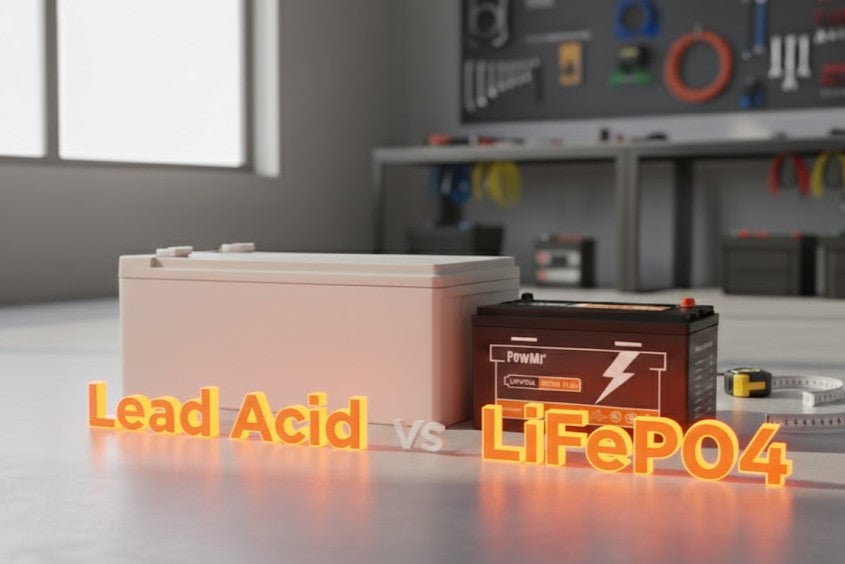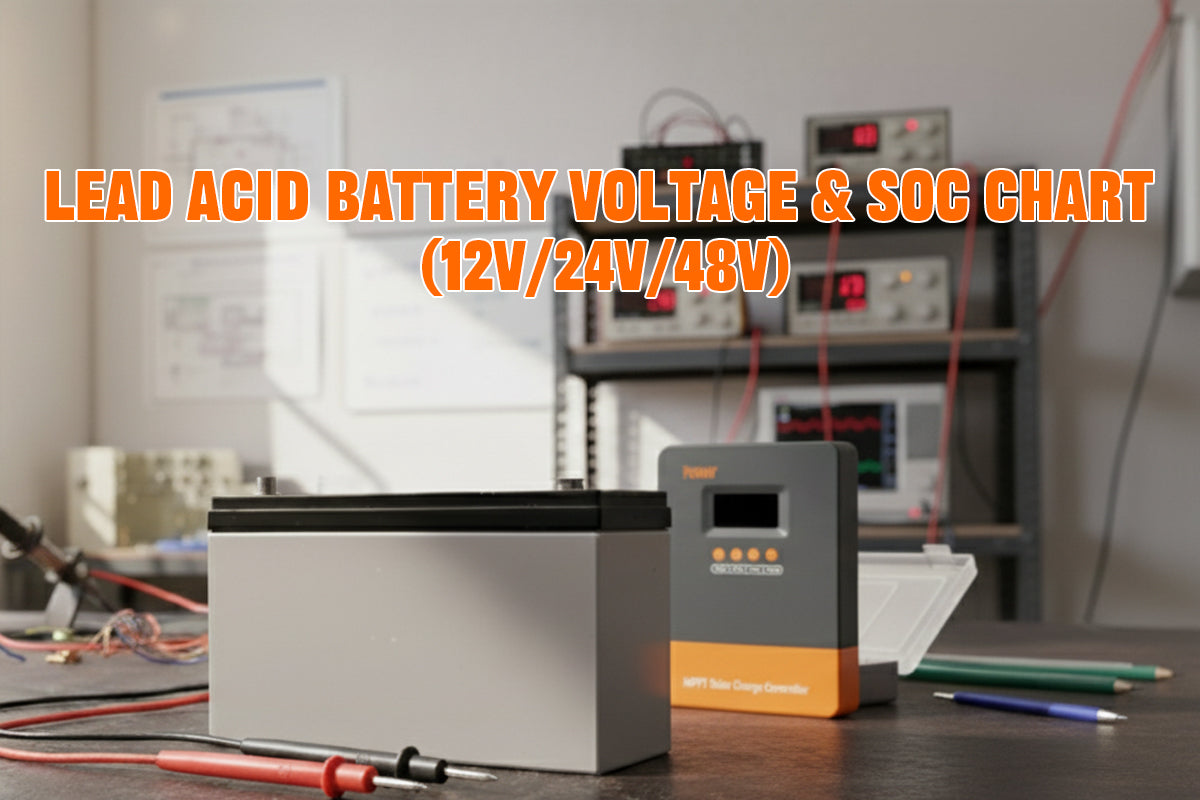"แบตเตอรี่ LiFePO4 อาจมีราคาสูงกว่าถึง 1.5 ถึง 3 เท่าของแบตเตอรี่ตะกั่วกรด! นั่นมันแพงมาก!" — นี่อาจเป็นความคิดแรกของคุณเมื่อเปิดบทความนี้ และใช่ ในสายตาแรก ราคาดูเหมือนจะทำให้แบตเตอรี่ตะกั่วกรดเป็นผู้ชนะที่ชัดเจน.
แต่การเลือกตัวเลือกแบตเตอรี่ตะกั่วกรดที่ "ถูกกว่า" อาจกลายเป็นการตัดสินใจที่แพงที่สุดสำหรับการจัดเก็บพลังงานของคุณในระยะยาว ฟังดูขัดแย้งใช่ไหม?
คู่มือนี้เจาะลึกเกินกว่าการเปรียบเทียบผิวเผินเพื่อมอบความเข้าใจทางเทคนิคและปฏิบัติที่จำเป็นสำหรับการตัดสินใจอย่างมั่นใจ เราจะวิเคราะห์ตัวชี้วัดสำคัญ เช่น การชาร์จ ความจุ ความทนทานต่อสภาพแวดล้อม และต้นทุนรวมของการเป็นเจ้าของ เพื่อให้คุณเลือกเคมีแบตเตอรี่ที่เหมาะสมสำหรับ RV เรือ หรือระบบพลังงานแสงอาทิตย์ออฟกริดของคุณ
วิธีการชาร์จ LiFePO4 เทียบกับ แบตเตอรี่ตะกั่วกรด
กระบวนการชาร์จเป็นหนึ่งในความแตกต่างที่สำคัญที่สุดในการใช้งานระหว่าง ลิเธียมเหล็กฟอสเฟต (LiFePO4) และแบตเตอรี่ตะกั่วกรด
กราฟการชาร์จแบตเตอรี่ LiFePO4
แบตเตอรี่ LiFePO4 ใช้อัลกอริทึมการชาร์จสองขั้นตอนที่เรียบง่ายและมีประสิทธิภาพเรียกว่า กระแสคงที่ / แรงดันคงที่ (CC/CV)
- กระแสคงที่ (CC): ในขั้นตอนแรก เครื่องชาร์จจะจ่าย กระแสไฟคงที่ เติมความจุส่วนใหญ่ของแบตเตอรี่ได้อย่างรวดเร็วและแรงดันแบตเตอรี่จะเพิ่มขึ้นอย่างต่อเนื่อง
- แรงดันคงที่ (CV): เมื่อแรงดันแบตเตอรี่ถึงขีดจำกัดที่ตั้งไว้ เครื่องชาร์จจะรักษา แรงดันให้คงที่ ความต้านทานภายในแบตเตอรี่เพิ่มขึ้นเมื่อแบตเตอรี่เต็ม ทำให้กระแสไฟที่รับได้ลดลงตามธรรมชาติ
บทความที่เกี่ยวข้อง:
กราฟการชาร์จแบตเตอรี่ตะกั่วกรด
การชาร์จแบตเตอรี่ตะกั่วกรด (รวมถึง Flooded, AGM, และ Gel) โดยทั่วไปประกอบด้วย สามขั้นตอน โดยสองขั้นตอนแรกคล้ายกับการชาร์จ LiFePO₄ และมีขั้นตอน "float" ที่สามเพื่อรักษาการชาร์จเต็ม
- Bulk: คล้ายกับขั้นตอน CC เครื่องชาร์จจะจ่ายกระแสไฟสูงสุดจนกว่าแรงดันแบตเตอรี่จะถึงจุดที่กำหนด (กระแสคงที่)
- Absorption: เครื่องชาร์จจะรักษาแรงดันดูดซับนี้ให้คงที่ในขณะที่กระแสไฟค่อยๆ ลดลง ขั้นตอนนี้สำคัญสำหรับการอิ่มตัวของแผ่นตะกั่วอย่างเต็มที่ แต่มีประสิทธิภาพต่ำและอาจใช้เวลาหลายชั่วโมง (แรงดันคงที่)
- Float: เมื่อขั้นตอนการดูดซับเสร็จสิ้น แรงดันไฟฟ้าจะถูกลดลงไปที่ระดับ "float" ซึ่งเป็นการชาร์จด้วยกระแสไฟต่ำอย่างต่อเนื่องเพื่อชดเชยอัตราการคายประจุเองตามธรรมชาติของแบตเตอรี่และรักษาให้เต็มอยู่เสมอ
บทความที่เกี่ยวข้อง:
ฉันสามารถใช้เครื่องชาร์จแบตเตอรี่ตะกั่วกรดกับ LiFePO4 ได้ไหม? (ทำไมถึงเป็นความคิดที่ไม่ดี)
ไม่แนะนำ เครื่องชาร์จแบตเตอรี่ตะกั่วกรด (รวมถึงไดชาร์จรถยนต์และตัวควบคุมการชาร์จพลังงานแสงอาทิตย์) มีขั้นตอน "Float" และ "Equalization" ซึ่งอาจทำให้แบตเตอรี่ LiFePO4 เสียหายและลดอายุการใช้งาน
วิธีแก้ปัญหาที่เหมาะสมคือเปลี่ยนเป็นเครื่องชาร์จที่มีโหมดชาร์จเฉพาะสำหรับ "Lithium" หรือ "LiFePO4" หากต้องใช้งานชั่วคราว ให้แน่ใจว่าแรงดันไฟฟ้าของเครื่องชาร์จอยู่ในช่วงที่ยอมรับได้สำหรับแบตเตอรี่ LiFePO4 และปิดโหมดชาร์จปรับสมดุล การใช้งานเครื่องชาร์จที่ไม่ถูกต้องเป็นเวลานานจะทำให้ความจุแบตเตอรี่เสื่อมและเกิดความเสียหาย
หมายเหตุ:เครื่องควบคุมการชาร์จ PowMr ช่วยให้เลือกโหมดระหว่าง LiFePO4 และแบตเตอรี่ตะกั่วกรดได้ โดยปรับเส้นโค้งการชาร์จ เพื่อป้องกันการชาร์จเกินและแรงดันไฟฟ้าเกิน ช่วยยืดอายุการใช้งานแบตเตอรี่
เส้นโค้งการคายประจุของ LiFePO4 เทียบกับแบตเตอรี่ตะกั่วกรด
แบตเตอรี่ตะกั่วกรด มีลักษณะโดย แรงดันไฟฟ้าลดลงอย่างรวดเร็ว เมื่อความลึกของการคายประจุ (DOD) ถึง ประมาณ 50% ของความจุ

ตามที่แสดงในเส้นโค้งการคายประจุที่เปรียบเทียบระหว่างแบตเตอรี่ตะกั่วกรดและ LiFePO₄ เส้นโค้งของแบตเตอรี่ตะกั่วกรดมีความลาดชันสูงและลื่นไหล โดยแรงดันไฟฟ้าจะลดลงอย่างรวดเร็วในช่วงกลางของการคายประจุ ในขณะที่ เส้นโค้งของ LiFePO₄ มีช่วงราบยาวนาน
พฤติกรรมนี้เกิดขึ้นเพราะในระหว่างการคายประจุ ความเข้มข้นของกรดซัลฟิวริกในอิเล็กโทรไลต์ของแบตเตอรี่ตะกั่วกรดลดลง ทำให้ไอออนไฮโดรเจนมีน้อยลง ในขณะเดียวกัน ความต้านทานภายในเพิ่มขึ้นเนื่องจากแผ่นอิเล็กโทรดถูกเคลือบด้วย PbSO₄ ลดกิจกรรมปฏิกิริยาและทำให้แรงดันไฟฟ้าลดลงอย่างรวดเร็ว
เส้นโค้งการคายประจุที่เรียบมากขึ้น หมายถึงพลังงานที่อุปกรณ์ของคุณได้รับอย่างสม่ำเสมอตลอดรอบการคายประจุทั้งหมด ความแตกต่างระหว่างแบตเตอรี่ทั้งสองนี้ส่งผลไม่เพียงแต่การจ่ายพลังงานตามเวลาเท่านั้น แต่ยังรวมถึงประสบการณ์การใช้งานจริงโดยรวมด้วย
เปรียบเทียบอย่างละเอียดระหว่างแบตเตอรี่ตะกั่วกรดกับ LiFePO4
เรามาแยกแยะความแตกต่างหลักใน การวิเคราะห์ทางเทคนิคแบบเปรียบเทียบกันโดยตรง ส่วนนี้จะวัดผลคำกล่าวอ้างและให้ข้อมูลที่คุณต้องการเพื่อเปรียบเทียบเคมีทั้งสองนี้โดยตรง
DoD และอายุการใช้งาน
เมื่อความลึกของการคายประจุเพิ่มขึ้น ผลึกตะกั่วซัลเฟต (PbSO₄) ที่ใหญ่ขึ้นและมีความเสถียรขึ้นจะก่อตัวบนขั้วลบของแบตเตอรี่ตะกั่วกรด ผลึกเหล่านี้ยากที่จะเปลี่ยนกลับเป็นวัสดุที่ใช้งานได้ ในระหว่างการชาร์จและสะสมเพิ่มขึ้นในแต่ละรอบ ดังนั้น แบตเตอรี่ตะกั่วกรดจึงมักจำกัดที่ 50% DoD เพื่อรักษาสมดุลที่เหมาะสมระหว่างการใช้พลังงานและความทนทาน
แบตเตอรี่ตะกั่วกรด deep-cycle บางรุ่น หลังจากเสริมความแข็งแรงโครงสร้างแล้ว สามารถใช้งานได้อย่างปลอดภัยที่ 60–70% DoD ตารางด้านล่างสรุปขีดจำกัด DoD ทั่วไปและอายุการใช้งานรอบที่สอดคล้องกันสำหรับแบตเตอรี่ตะกั่วกรดประเภทต่างๆ:
| ประเภทแบตเตอรี่ | DoD สูงสุดที่แนะนำ | อายุการใช้งานรอบทั่วไป |
|---|---|---|
| แบตเตอรี่ตะกั่วกรดชนิดน้ำท่วม | 50% | 300-500 รอบ |
| AGM | 60 - 70% | 400-600 รอบ |
| เจล | 50% | 500-800 รอบ |
| LiFePO4 | 80-90% | 3000-5000+ รอบ |
ความจุและการใช้งานได้จริง
ดังนั้น เพื่อยืดอายุการใช้งานแบตเตอรี่ ผู้ใช้ควร หลีกเลี่ยงการคายประจุ แบตเตอรี่ออกไป เกิน ขีดจำกัด ความลึกของการคายประจุ ที่ผู้ผลิตแนะนำ ซึ่งหมายความว่าแม้แบตเตอรี่จะมี ความจุที่ระบุเท่ากัน แต่สามารถจ่ายพลังงานที่ใช้ได้แตกต่างกัน ขึ้นอยู่กับเคมีของแบตเตอรี่
ตัวอย่างเช่น แม้ว่าทั้งสองจะมีความจุ 100Ah แต่แบตเตอรี่ตะกั่ว-กรดที่คายประจุถึง 50% DoD ให้พลังงานที่ใช้ได้เพียง 50 Ah ในขณะที่ แบตเตอรี่ LiFePO₄ 100Ah สามารถจ่ายพลังงานได้อย่างปลอดภัยถึง 80Ah
การยอมรับการชาร์จ
ความเร็วที่แบตเตอรี่สามารถชาร์จได้อย่างปลอดภัยเป็นปัจจัยสำคัญและวัดโดย "C-rate," ซึ่ง 1C คือกระแสชาร์จเท่ากับค่าความจุ Ah ของแบตเตอรี่
แบตเตอรี่ตะกั่ว-กรด โดยทั่วไปจำกัดอัตราการชาร์จที่ 0.1C ถึง 0.2C (แบตเตอรี่ 100Ah รับกระแชาร์จได้เพียง 10-20A) ช่วงการดูดซับชาร์จช้าและไม่มีประสิทธิภาพ การชาร์จเต็มแบตเตอรี่ตะกั่ว-กรดจาก 50% อาจใช้เวลาถึง 6-10 ชั่วโมง
แบตเตอรี่ LiFePO4 สามารถรับการชาร์จด้วยอัตราที่สูงมาก โดยปกติ ตั้งแต่ 0.5C ถึง 1C (แบตเตอรี่ 100Ah สามารถชาร์จด้วยกระแส 50A ถึง 100A) ซึ่งหมายความว่าคุณสามารถชาร์จแบตเตอรี่ LiFePO4 จากสถานะว่างจนเต็มได้ภายในเวลาเพียง 1-2 ชั่วโมง
การปรับสมดุลแบตเตอรี่
ในแบตเตอรี่ตะกั่ว-กรด ที่ เซลล์ถูกสร้างรวมกันเป็นโครงสร้างที่แข็งแรงและเป็นหนึ่งเดียว จะปรับสมดุลด้วยตัวเองแบบพาสซีฟผ่านการแพร่ของอิเล็กโทรไลต์และการเท่ากันของความต้านทานภายใน เมื่อเซลล์เกิดความไม่สมดุลจากการเกิดซัลเฟตหรือการแยกชั้นของอิเล็กโทรไลต์ จะเป็นเรื่องยากมากที่จะฟื้นฟูประสิทธิภาพให้สม่ำเสมอ การชาร์จปรับสมดุลเป็นประจำ (การชาร์จเกินที่ควบคุมด้วยกระแสต่ำ) ช่วยลดความไม่สมดุลแต่เพิ่มการสูญเสียน้ำ ความร้อน และการกัดกร่อนของแผ่น
แบตเตอรี่ LiFePO₄ ในทางตรงกันข้าม ประกอบด้วยเซลล์หลายเซลล์ที่เชื่อมต่อกันแบบอนุกรม เพื่อให้ได้แรงดันไฟฟ้าที่ต้องการ และแรงดันของแต่ละเซลล์ต้องถูกควบคุมอย่างเข้มงวดในช่วงแคบ เพื่อปรับสมดุลเซลล์ภายในชุดแบตเตอรี่ จะมีระบบจัดการแบตเตอรี่ (BMS) ที่ติดตั้งมาเพื่อเฝ้าตรวจสอบอย่างต่อเนื่อง ปรับสมดุลเซลล์ และป้องกันการชาร์จเกิน การคายประจุเกิน ไฟฟ้าลัดวงจร และการลุกลามของความร้อนโดยการตัดการเชื่อมต่อแบตเตอรี่อัตโนมัติเมื่อเกินขีดจำกัด
ความหนาแน่นพลังงาน
ความหนาแน่นพลังงานวัด ว่ามีพลังงานที่แบตเตอรี่สามารถจ่ายได้เทียบกับน้ำหนัก หรือปริมาตร โดยปกติในหน่วยวัตต์ต่อกิโลกรัม (W/kg)
แบตเตอรี่ตะกั่ว-กรด มีความหนาแน่นพลังงานค่อนข้างต่ำ โดยปกติ อยู่ระหว่าง 180–300 W/kg กระแสไฟฟ้าสูงที่ปล่อยออกมาทำให้แรงดันไฟฟ้าตกอย่างมาก เกิดความร้อนสะสม และการเกิดซัลเฟตอย่างรวดเร็ว ซึ่งลดทั้งประสิทธิภาพและอายุการใช้งานของแบตเตอรี่ ดังนั้น แบตเตอรี่ตะกั่ว-กรดจึงเหมาะกับการใช้งานที่มีโหลดคงที่และปานกลางมากกว่าการจ่ายพลังงานแบบรวดเร็ว
ในทางตรงกันข้าม แบตเตอรี่ LiFePO₄ มีความหนาแน่นพลังงานสูงกว่ามาก โดยมักอยู่ในช่วง 1,000–2,500 วัตต์/กก. ความต้านทานภายในต่ำช่วยให้รักษาแรงดันไฟฟ้าได้เสถียรภายใต้โหลดกระแสสูงโดยมีการสร้างความร้อนน้อยมาก ทำให้เหมาะสำหรับการใช้งานที่ต้องการการจ่ายพลังงานอย่างรวดเร็ว เช่น ยานยนต์ไฟฟ้า อินเวอร์เตอร์กำลังสูง หรือการลดพีคในระบบพลังงานหมุนเวียน
น้ำหนักและขนาด
ความแตกต่างของความหนาแน่นพลังงานส่งผลโดยตรงต่อน้ำหนักและขนาดทางกายภาพระหว่างแบตเตอรี่ตะกั่วกรดและ LiFePO4
ตัวอย่างเช่น แบตเตอรี่ LiFePO₄ 12 V, 100 Ah มีน้ำหนักเพียง 11.5 กก. และขนาด 330 × 171 × 215 มม. เทียบกับ แบตเตอรี่ตะกั่วกรดทั่วไปที่มีน้ำหนัก 28–37 กก. และขนาด 507 × 240 × 174 มม.
นี่แสดงถึงการลดน้ำหนักมากกว่า 50–60% และการประหยัดพื้นที่ประมาณ 40–45% ทำให้แบตเตอรี่ LiFePO₄ มีน้ำหนักเบาและกะทัดรัดมากขึ้นอย่างมีนัยสำคัญสำหรับความจุเท่ากัน
ความทนทานต่อสิ่งแวดล้อม
ประสิทธิภาพของแบตเตอรี่ในอุณหภูมิสุดขั้วเป็นข้อจำกัดสำคัญในการใช้งาน
อากาศหนาว: นี่คือจุดที่ แบตเตอรี่ตะกั่วกรด มีข้อได้เปรียบตามธรรมชาติเล็กน้อยในการปล่อยประจุ ความจุจะลดลงในสภาพหนาวเย็น แต่ยังสามารถปล่อยและชาร์จได้ (แม้ว่าจะช้า) จนถึงประมาณ -20°C ถึง -30°C (-4°F ถึง -22°F) ขึ้นอยู่กับชนิดและอิเล็กโทรไลต์
แบตเตอรี่ LiFePO4 สามารถปล่อยประจุในอุณหภูมิเย็น (ต่ำสุดถึง -20°C / -4°F) โดยมีการลดความจุเพียงเล็กน้อย อย่างไรก็ตาม จุดอ่อนที่สำคัญคือการชาร์จในอุณหภูมิต่ำกว่า 0°C (32°F) การพยายามชาร์จแบตเตอรี่ LiFePO4 มาตรฐานในอุณหภูมิต่ำกว่าจุดเยือกแข็งอาจทำให้เกิดการชุบลิเธียม ซึ่งเป็นกระบวนการที่ไม่สามารถย้อนกลับได้และทำลายเซลล์อย่างถาวร
เคล็ดลับมือโปร: เพื่อแก้ปัญหานี้ แบตเตอรี่ LiFePO4 คุณภาพสูงหลายรุ่นมาพร้อมระบบทำความร้อนภายใน ระบบเหล่านี้ใช้กระแสชาร์จเล็กน้อยเพื่อทำให้เซลล์อุ่นขึ้นจนถึงอุณหภูมิที่ปลอดภัยก่อนเริ่มชาร์จ ทำให้เป็นโซลูชันที่ใช้งานได้ตลอดทั้งสี่ฤดูอย่างแท้จริง
อากาศร้อน: LiFePO4 โดดเด่นในสภาพอากาศร้อน แม้อุณหภูมิสูงจะเร่งการเสื่อมสภาพในแบตเตอรี่ทุกชนิด แต่แบตเตอรี่ตะกั่วกรดจะมีอายุการใช้งานที่สั้นลงอย่างมาก สำหรับทุกๆ การเพิ่มขึ้น 10°C (18°F) เหนือ 25°C (77°F) อายุการใช้งานของแบตเตอรี่ตะกั่วกรดจะลดลงครึ่งหนึ่ง ดังนั้นจึงมีขีดจำกัดอุณหภูมิการใช้งานสูงสุดประมาณ 50°C (122°F) แบตเตอรี่ LiFePO4 ยังคงรักษาประสิทธิภาพและอายุการใช้งานได้อย่างมีประสิทธิผลมากขึ้นในอุณหภูมิที่สูงขึ้น (สูงสุดถึง 45-55°C / 113-131°F).
ความปลอดภัยและการบำรุงรักษา
แบตเตอรี่ตะกั่วกรดโดยทั่วไปถือว่าปลอดภัยแต่มีความเสี่ยงและข้อกำหนดในการบำรุงรักษาบางประการ ในขณะที่เคมี LiFePO₄ มีความปลอดภัยโดยธรรมชาติและดูแลรักษาง่ายกว่า
แบตเตอรี่ตะกั่วกรด:
แบตเตอรี่ตะกั่วกรด มีแนวโน้มเกิดซัลเฟตและการแยกชั้นภายใน และ ปล่อยก๊าซ ในระหว่างการชาร์จด้วยกระแสสูง การปล่อยก๊าซนี้ก่อให้เกิดไฮโดรเจนและออกซิเจนที่ระเบิดได้ จึงจำเป็นต้องมีการระบายอากาศที่เหมาะสม
การชาร์จเกินแบตเตอรี่แบบน้ำท่วมทำให้อิเล็กโทรไลต์ เดือดและระเหย จำเป็นต้องมีการ ตรวจสอบระดับน้ำอย่างสม่ำเสมอและเติมน้ำกลั่น พร้อมทั้งทำความสะอาดขั้วแบตเตอรี่เพื่อป้องกันการกัดกร่อน และทำ "การชาร์จปรับสมดุล" เพื่อย้อนกลับการเกิดซัลเฟต แม้ว่าแบตเตอรี่ AGM และเจลจะเป็น "ไม่ต้องบำรุงรักษา" ด้วยระบบ BMS ในตัวสำหรับการจัดการอัตโนมัติ แต่การปล่อยไฟเกินหรือการชาร์จที่ไม่เหมาะสมเป็นเวลานานยังคงทำให้เกิดซัลเฟตหรือสูญเสียความจุได้
LiFePO4:
แบตเตอรี่ LiFePO4 มีคุณสมบัติทางเคมีที่เสถียรอย่างยิ่ง ไม่จำเป็นต้องเติมอิเล็กโทรไลต์หรือชาร์จปรับสมดุล พวกมันไม่ผลิตก๊าซไฮโดรเจนในระหว่างการใช้งานปกติและใช้การออกแบบแบบปิดผนึก ซึ่งช่วยขจัดปัญหาการระบายอากาศที่เกี่ยวข้องกับแบตเตอรี่ตะกั่วกรด แบตเตอรี่เหล่านี้มาพร้อมกับระบบ BMS ที่ป้องกันการชาร์จเกิน การปล่อยไฟเกิน กระแสเกิน และอุณหภูมิที่รุนแรง ซึ่งช่วยเพิ่มความปลอดภัยและยืดอายุการใช้งาน
ประสิทธิภาพการชาร์จ
ประสิทธิภาพรอบการชาร์จ-ปล่อยไฟวัดจากพลังงานที่คุณได้รับจากแบตเตอรี่เทียบกับพลังงานที่คุณใส่เข้าไป พลังงานที่สูญเสียส่วนใหญ่จะเปลี่ยนเป็นความร้อน
ข้อมูลจากอุตสาหกรรมแสดงให้เห็นว่า แบตเตอรี่ตะกั่วกรด มีประสิทธิภาพรอบการชาร์จ-ปล่อยไฟประมาณ 80-85% สำหรับพลังงานแสงอาทิตย์ 100 วัตต์ที่คุณผลิตเพื่อชาร์จแบตเตอรี่ คุณจะสามารถใช้พลังงานได้เพียง 80-85 วัตต์ ส่วนที่เหลือ 15-20 วัตต์จะสูญเสียไปในรูปแบบความร้อนระหว่างกระบวนการชาร์จ
แบตเตอรี่ LiFePO4 มีประสิทธิภาพสูงมาก โดยมีประสิทธิภาพรอบการชาร์จ-ปล่อยไฟอยู่ที่ 95-98% พลังงานแสงอาทิตย์ 100 วัตต์ที่ได้รับจะกลายเป็นพลังงานที่ใช้ได้จริง 95-98 วัตต์ ตลอดอายุการใช้งานของแบตเตอรี่ สิ่งนี้ช่วยประหยัดพลังงานอย่างมากและช่วยให้คุณสามารถกำหนดขนาดแผงโซลาร์เซลล์ได้อย่างมีประสิทธิภาพมากขึ้น
แบตเตอรี่ตะกั่วกรดกับ LiFePO4 แบบไหนเหมาะกับคุณ?
การเลือกใช้แบตเตอรี่แบบตะกั่วกรดหรือ LiFePO4 ไม่ได้ขึ้นอยู่กับราคาตั้งต้นเท่านั้น แต่เป็นการปรับความสามารถของแบตเตอรี่ให้สอดคล้องกับความต้องการ ลำดับความสำคัญ และเป้าหมายระยะยาวของคุณ
แบตเตอรี่ที่ "เหมาะสม" คือแบตเตอรี่ที่แก้ปัญหาของคุณโดยไม่สร้างปัญหาใหม่ คุณต้องการทางออกที่เรียบง่ายและต้นทุนต่ำสำหรับการใช้งานไม่บ่อย หรือแหล่งพลังงานที่มีประสิทธิภาพสูงและใช้งานได้นานที่คุณวางใจได้ทุกวัน?
ส่วนถัดไปนี้จะให้กรอบการตัดสินใจที่ชัดเจนเพื่อช่วยให้คุณเลือกได้อย่างมั่นใจ
แบตเตอรี่ตะกั่วกรด vs LiFePO4 - ข้อดีและข้อเสีย
เพื่อให้การเปรียบเทียบชัดเจนที่สุด เรามาสรุปความแตกต่างหลักที่เราได้พูดถึงในรูปแบบเปรียบเทียบกันโดยตรง
| คุณสมบัติ | ตะกั่วกรด | LiFePO4 |
|---|---|---|
| ต้นทุนเริ่มต้น | ต่ำ ($100-$300 สำหรับ 100Ah) | สูง ($500-$800 สำหรับ 100Ah) |
| ความจุที่ใช้งานได้ | 50% (50Ah จาก 100Ah) | 80-90% (80-90Ah จาก 100Ah) |
| อายุการใช้งานรอบ | 300-800 รอบ | 3000-5000+ รอบ |
| เวลาชาร์จ | 6-10 ชั่วโมง | 1-2 ชั่วโมง |
| น้ำหนัก | หนัก | เบา |
| การบำรุงรักษา | บำรุงรักษาปกติ (เติมน้ำ, ทำความสะอาด, การปรับสมดุล) | ไม่มี (บำรุงรักษาศูนย์) |
| กราฟการปล่อยประจุ | แรงดันไฟฟ้าตกอย่างรวดเร็ว | แรงดันไฟฟ้าเรียบและเสถียร |
| ประสิทธิภาพตามอุณหภูมิ | แย่ในความร้อน, ใช้ได้ในที่เย็น | ยอดเยี่ยมในความร้อน, ต้องการความร้อนสำหรับการชาร์จในที่เย็น |
| ประสิทธิภาพ | 80-85% | 95-98% |
| ความปลอดภัย | ความเสี่ยงของก๊าซไฮโดรเจน, กรดกัดกร่อน | เคมีเสถียร, มีการป้องกัน BMS |
เมื่อแบตเตอรี่ตะกั่วกรดดีกว่า
มีสถานการณ์เฉพาะที่ธรรมชาติที่พิสูจน์แล้วและต้นทุนต่ำของแบตเตอรี่ตะกั่วกรดทำให้เป็นตัวเลือกที่สมเหตุสมผลมากกว่า คุณควรใช้แบตเตอรี่ตะกั่วกรดหาก:
- คุณมีงบประมาณเริ่มต้นที่เข้มงวด หากราคาซื้อเริ่มต้นเป็นปัจจัยสำคัญที่สุดและคุณไม่สามารถรับภาระต้นทุนที่สูงกว่าของ LiFePO4 ได้ แบตเตอรี่ตะกั่วกรดเป็นวิธีที่ใช้งานได้และประหยัดเพื่อให้ระบบของคุณทำงาน
- การใช้งานของคุณสำหรับสแตนด์บายหรือสำรองฉุกเฉิน สำหรับระบบที่แทบจะไม่ถูกปล่อยประจุ เช่น ปั๊มน้ำทิ้งในบ้านหรือ UPS ที่ใช้เวลาส่วนใหญ่ 99% ในการชาร์จแบบลอย ชีวิตการใช้งานยาวนานของ LiFePO4 จึงไม่มีประโยชน์จริง
- การใช้งานของคุณไม่บ่อยและเบามาก หากคุณเป็น "นักรบวันหยุดสุดสัปดาห์" ที่ใช้รถบ้านหรือเรือเล็กของคุณเพียงไม่กี่ครั้งต่อปีสำหรับการเดินทางสั้น ๆ ที่ต้องการพลังงานน้อย ระยะเวลาคืนทุนสำหรับแบตเตอรี่ลิเธียมอาจนานเกินไปจนไม่เหมาะสม
- คุณต้องชาร์จในอุณหภูมิเยือกแข็งโดยไม่มีแบตเตอรี่ที่มีระบบทำความร้อน หากระบบของคุณต้องสามารถรับการชาร์จในสภาพอุณหภูมิต่ำกว่าศูนย์องศาและคุณไม่มีแบตเตอรี่ LiFePO4 ที่มีฟังก์ชันทำความร้อนในตัว ความสามารถของแบตเตอรี่ตะกั่วกรดในการชาร์จ (แม้จะช้า) ในความเย็นเป็นข้อได้เปรียบสำคัญ
เมื่อ LiFePO4 ดีกว่า
เหตุผลสำหรับ LiFePO4 นั้นน่าสนใจและแข็งแกร่งขึ้นทุกปี มันเป็นตัวเลือกที่เหนือกว่าหาก:
- คุณพึ่งพาแบตเตอรี่ของคุณทุกวัน สำหรับการใช้ชีวิตนอกระบบไฟฟ้า การเดินทางด้วย RV แบบเต็มเวลา หรือการล่องเรือในทะเล อายุการใช้งานและประสิทธิภาพของ LiFePO4 เป็นประโยชน์ที่ไม่อาจต่อรองได้ คำตอบสำหรับคำถาม "คุ้มค่าหรือไม่ที่จะอัปเกรด RV เป็นแบตเตอรี่ลิเธียม" คือใช่แน่นอนสำหรับผู้ใช้ RV จริงจังทุกคน
- น้ำหนักเป็นปัจจัยสำคัญ ในรถ RV รถบ้าน เรือ และการใช้งานแบบพกพา การประหยัดน้ำหนัก 50-60% เป็นข้อได้เปรียบอย่างมาก
- การชาร์จเร็วเป็นสิ่งสำคัญ หากคุณใช้พลังงานแสงอาทิตย์หรือเครื่องกำเนิดไฟฟ้า ความสามารถในการชาร์จใหม่ภายใน 1-3 ชั่วโมง (เทียบกับ 8-10 ชั่วโมง) จะเปลี่ยนวิธีการจัดการพลังงานของคุณอย่างสิ้นเชิง
- คุณต้องการระยะเวลาการใช้งานที่ยาวนานสำหรับอุปกรณ์ที่ต้องการพลังงานสูง LiFePO4 เหมาะอย่างยิ่งสำหรับการจ่ายพลังงานให้กับอุปกรณ์เช่น ไมโครเวฟ เครื่องปรับอากาศ หรือมอเตอร์ลากเรือ แรงดันไฟฟ้าที่เสถียรภายใต้ภาระช่วยป้องกันการปิดอินเวอร์เตอร์ก่อนเวลาอันควรซึ่งเป็นเรื่องปกติกับแบตเตอรี่ตะกั่วกรด ทำให้คุณสามารถใช้ความจุการปล่อยลึกเต็มที่ของแบตเตอรี่ได้นานขึ้นอย่างมีนัยสำคัญ
- คุณให้ความสำคัญกับระบบที่ไม่ต้องบำรุงรักษา หากคุณต้องการติดตั้งแบตเตอรี่และไม่ต้องกังวลเรื่องการเติมน้ำ การทำความสะอาดขั้ว หรือการชาร์จปรับสมดุล การออกแบบแบตเตอรี่ LiFePO4 ที่ไม่ต้องบำรุงรักษาพร้อม BMS ในตัวจะมอบความสบายใจและความน่าเชื่อถือสูงสุด
คำถามที่พบบ่อย (FAQ)
1. ฉันสามารถผสมแบตเตอรี่ LiFePO4 กับแบตเตอรี่ตะกั่วกรดได้หรือไม่?
ไม่เลย โปรไฟล์แรงดันไฟฟ้าที่แตกต่างกัน ความต้องการชาร์จ และความต้านทานภายในจะทำให้พวกมันต่อสู้กัน นำไปสู่สภาวะการชาร์จที่อันตรายและทำลายแบตเตอรี่ทั้งสอง
2. แบตเตอรี่ LiFePO4 ปลอดภัยหรือไม่?
ใช่ ลิเธียมไอรอนฟอสเฟต (LFP) เป็นเคมีลิเธียมไอออนที่ปลอดภัยและมีความเสถียรทางความร้อนสูงสุด เมื่อจับคู่กับ BMS คุณภาพดี พวกมันปลอดภัยกว่าก้อนตะกั่วกรดแบบดั้งเดิมอย่างมาก ซึ่งอาจปล่อยก๊าซไฮโดรเจนที่ระเบิดได้
3. แบตเตอรี่ LiFePO4 ใช้ไม่ได้ในฤดูหนาวหรือ? ผมได้ยินว่าพวกมันชาร์จไม่ได้ที่อุณหภูมิต่ำ
ใช่ แต่มีวิธีแก้ไข:
- ซื้อ BMS (ระบบจัดการแบตเตอรี่) ที่มีการป้องกันการตัดการชาร์จเมื่ออุณหภูมิต่ำในตัว มันจะป้องกันการชาร์จโดยอัตโนมัติเมื่ออุณหภูมิต่ำกว่าจุดเยือกแข็ง
- ซื้อแบตเตอรี่ LiFePO4 ที่มีฟังก์ชันทำความร้อนในตัว พวกมันใช้กระแสชาร์จเพื่อทำความร้อนตัวเองให้ถึงอุณหภูมิที่ปลอดภัยก่อนเริ่มชาร์จ
- ติดตั้งแบตเตอรี่ภายในรถหรือในกล่องที่มีฉนวนกันความร้อน ห่างจากสภาพแวดล้อมภายนอกที่เย็นจัด



